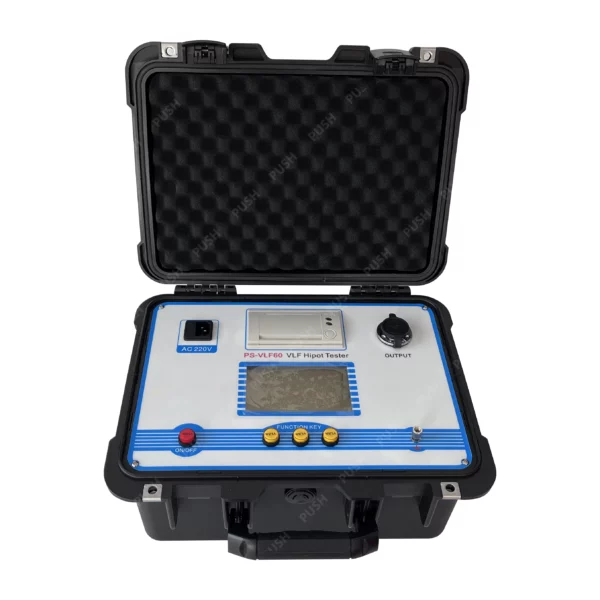How does a Transformer Hi-Pot Tester assist in identifying potential faults or weaknesses in the insulation of distribution transformers?
A Transformer Hi-Pot Tester plays a critical role in identifying potential faults or weaknesses in the insulation of distribution transformers by subjecting the transformer’s insulation system to high-voltage stress.
Here’s how it assists in this process:
- High Voltage Stress Testing: The primary function of a Transformer Hi-Pot Tester is to apply a significantly higher voltage to the transformer’s insulation system than it would encounter during normal operation. This stress testing is designed to identify any weaknesses or defects in the insulation.
- Dielectric Strength Evaluation: During the high-pot test, the tester gradually increases the voltage applied to the transformer. The insulation is expected to withstand this increased voltage without breaking down. The test measures the dielectric strength of the insulation, which is its ability to resist electrical breakdown.
- Detection of Weaknesses: If there are any faults or weaknesses in the insulation, such as tiny cracks, voids, or contaminants, they can cause localized areas of higher electric field stress. As the voltage is increased, these areas may break down, leading to the formation of partial discharges, corona, or even flashovers. These breakdowns or anomalies are detected by the Hi-Pot Tester.
- Leakage Current Measurement: A crucial aspect of the Hi-Pot Test is the measurement of leakage current. As the voltage is applied, any increase in leakage current is an indicator of potential problems in the insulation. Higher leakage current can signify the presence of moisture, contamination, or defects in the insulation.
- Evaluation and Analysis: The results of the Hi-Pot Test are evaluated to determine if the transformer’s insulation is within acceptable parameters. The data obtained during the test, including voltage breakdown points and leakage current values, are analyzed to assess the insulation’s quality.
- Identification of Weak Spots: If the test reveals any breakdowns or higher leakage currents at specific points, it helps pinpoint potential weak spots or defects in the insulation. These weak spots can then be further examined and addressed through maintenance or repair.
- Preventive Maintenance: Identifying potential faults or weaknesses in the insulation during a Hi-Pot Test allows for preventive maintenance. Early detection and repair of insulation issues can extend the lifespan of the transformer and reduce the risk of unexpected failures.
- Quality Control: In manufacturing environments, transformer hi pot tester Hi-Pot Tests are used to ensure that distribution transformers meet quality standards before being deployed in the field. This helps manufacturers identify faulty transformers and prevent them from reaching customers.
In summary, a Transformer Hi-Pot Tester assists in identifying faults and weaknesses in the insulation of distribution transformers by applying high-voltage stress and monitoring the response of the insulation. The ability to detect these issues early through testing is crucial for ensuring the reliability and safety of transformers in distribution networks.
What are the advantages of using a Transformer Hi-Pot Tester for testing the insulation of power transformers in a factory setting?
Using a Transformer Hi-Pot Tester for testing the insulation of power transformers in a factory setting offers several advantages, contributing to the quality, reliability, and safety of transformers.
Here are the key advantages:
- Early Fault Detection: Hi-Pot testing allows for the early detection of insulation faults or weaknesses in the manufacturing process, helping to identify and rectify issues before transformers are deployed in the field. This reduces the likelihood of in-service failures and costly recalls.
- Quality Assurance: Hi-Pot tests are a crucial element of quality assurance in transformer manufacturing. They ensure that transformers meet industry standards and specifications, guaranteeing that the products leaving the factory are of high quality and reliable.
- Dielectric Strength Assessment: The tests assess the dielectric strength of the insulation, confirming its ability to withstand high-voltage stresses and ensuring safe operation in real-world applications.
- Compliance with Standards: Hi-Pot testing helps manufacturers comply with international standards and regulations (e.g., IEEE, IEC) related to transformer production and testing, enhancing product credibility and market acceptance.
- Preventing Field Failures: By identifying insulation weaknesses early, Hi-Pot testing reduces the risk of transformers failing in the field due to dielectric breakdowns or partial discharges, which can be expensive and disruptive for end-users.
- Cost Savings: Preventing field failures and recalls due to insulation faults saves manufacturers substantial costs associated with warranty claims, repairs, and replacements. It also protects the reputation of the manufacturer.
- Safety Assurance: Ensuring the integrity of insulation is essential for transformer safety. Transformers are often installed in populated areas, and insulation failures can lead to electrical accidents or fires. Hi-Pot tests enhance the safety of transformers.
- Data Analysis: Hi-Pot testers provide data on breakdown voltages and leakage currents, enabling manufacturers to analyze and monitor the quality of their transformers over time. Trends in test results can help improve manufacturing processes.
- Product Reliability: Testing transformers for insulation integrity enhances their overall reliability. This is especially important for critical applications, such as in the power grid, where reliability is paramount.
- Efficiency and Productivity: Hi-Pot testing is a relatively quick and efficient process, allowing manufacturers to test a large number of transformers in a relatively short time, contributing to production efficiency.
- Extended Lifespan: Detecting and addressing insulation issues during the manufacturing stage can extend the operational lifespan of transformers, reducing the frequency of maintenance and replacement.
- Customer Confidence: Manufacturers can confidently deliver products that have undergone rigorous testing, instilling trust and confidence in their customers.
In summary, using a Transformer Hi-Pot Tester in a factory setting provides numerous advantages, including early fault detection, quality assurance, cost savings, safety assurance, and enhanced product reliability. It ensures that transformers meet industry standards and are fit for safe and reliable operation in real-world applications, contributing to both the manufacturer’s and end-users’ satisfaction.


Comments are closed.